 |
 |
Our enthusiastic and extremely knowledgeable perennials team is here to answer your questions and help you choose the best perennials for your situation. There’s always something in bloom for sun, shade, butterflies, birds or deer resistance as well as a variety of bulbs for your space.
Stroll through our time-tested favorites and introduce yourself to the newest varieties. We garden with perennials too; we love them and it shows!
|
52 found, showing page 2 of 4
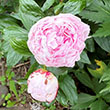
Height: 3 feet
Spacing: 30 inches
Sunlight: full sun
Hardiness Zone: 2a
Ornamental Features:
Sarah Bernhardt Peony features bold fragrant shell pink flowers at the ends of the stems from late spring to early summer. The flowers are excellent for cutting. Its compound leaves remain green in color throughout the season.
Landscape Attributes:
Sarah Bernhardt Peony is an herbaceous perennial with a more or less rounded form. Its medium texture blends into the garden, but can always be balanced by a couple of finer or coarser plants for an effective composition.
This is a relatively low maintenance plant, and should be cut back in late fall in preparation for winter. Deer don't particularly care for this plant and will usually leave it alone in favor of tastier treats. Gardeners should be aware of the following characteristic(s) that may warrant special consideration:
- Disease
Sarah Bernhardt Peony is recommended for the following landscape applications:
- Mass Planting
- General Garden Use
Planting & Growing:
Sarah Bernhardt Peony will grow to be about 30 inches tall at maturity, with a spread of 3 feet. When grown in masses or used as a bedding plant, individual plants should be spaced approximately 30 inches apart. The flower stalks can be weak and so it may require staking in exposed sites or excessively rich soils. It grows at a slow rate, and under ideal conditions can be expected to live for approximately 20 years. As an herbaceous perennial, this plant will usually die back to the crown each winter, and will regrow from the base each spring. Be careful not to disturb the crown in late winter when it may not be readily seen!
This plant should only be grown in full sunlight. It prefers to grow in average to moist conditions, and shouldn't be allowed to dry out. It is not particular as to soil pH, but grows best in rich soils. It is somewhat tolerant of urban pollution. This particular variety is an interspecific hybrid. It can be propagated by division; however, as a cultivated variety, be aware that it may be subject to certain restrictions or prohibitions on propagation.
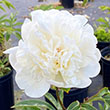
Plant Height: 24 inches
Flower Height: 3 feet
Spacing: 30 inches
Sunlight: full sun, partial shade
Hardiness Zone: 2a
Description:
An heirloom variety with large, globular double white blooms streaked with red at the center; a dependable, fragrant and vigorous plant; strong stems but staking required
Ornamental Features:
Festiva Maxima Peony features bold lightly-scented white flowers with crimson streaks at the ends of the stems from late spring to early summer. The flowers are excellent for cutting. Its compound leaves emerge burgundy in spring, turning green in color throughout the season.
Landscape Attributes:
Festiva Maxima Peony is an herbaceous perennial with a more or less rounded form. Its medium texture blends into the garden, but can always be balanced by a couple of finer or coarser plants for an effective composition.
This is a relatively low maintenance plant, and should be cut back in late fall in preparation for winter. It is a good choice for attracting bees and butterflies to your yard, but is not particularly attractive to deer who tend to leave it alone in favor of tastier treats. Gardeners should be aware of the following characteristic(s) that may warrant special consideration:
- Disease
Festiva Maxima Peony is recommended for the following landscape applications:
- Mass Planting
- General Garden Use
Planting & Growing:
Festiva Maxima Peony will grow to be about 24 inches tall at maturity extending to 3 feet tall with the flowers, with a spread of 3 feet. When grown in masses or used as a bedding plant, individual plants should be spaced approximately 30 inches apart. The flower stalks can be weak and so it may require staking in exposed sites or excessively rich soils. It grows at a slow rate, and under ideal conditions can be expected to live for approximately 20 years. As an herbaceous perennial, this plant will usually die back to the crown each winter, and will regrow from the base each spring. Be careful not to disturb the crown in late winter when it may not be readily seen!
This plant does best in full sun to partial shade. It does best in average to evenly moist conditions, but will not tolerate standing water. It is not particular as to soil pH, but grows best in rich soils. It is somewhat tolerant of urban pollution. This particular variety is an interspecific hybrid. It can be propagated by division; however, as a cultivated variety, be aware that it may be subject to certain restrictions or prohibitions on propagation.
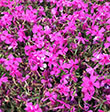
Height: 5 inches
Spacing: 15 inches
Sunlight: full sun, partial shade
Hardiness Zone: 2a
Other Names: Drummond Pink Phlox, Creeping Phlox
Description:
This variety produces a dazzling display of large, hot pink flowers that blanket the plant in spring; prune lightly after flowering to encourage a dense growth habit; wonderful for rock gardens, edging, or in mixed containers
Ornamental Features:
Drummond's Pink Moss Phlox is smothered in stunning hot pink star-shaped flowers at the ends of the stems from early to late spring. Its tiny needle-like leaves remain forest green in color throughout the year.
Landscape Attributes:
Drummond's Pink Moss Phlox is a dense herbaceous evergreen perennial with a ground-hugging habit of growth. It brings an extremely fine and delicate texture to the garden composition and should be used to full effect.
This plant will require occasional maintenance and upkeep, and should only be pruned after flowering to avoid removing any of the current season's flowers. It is a good choice for attracting bees, butterflies and hummingbirds to your yard, but is not particularly attractive to deer who tend to leave it alone in favor of tastier treats. Gardeners should be aware of the following characteristic(s) that may warrant special consideration:
- Spreading
Drummond's Pink Moss Phlox is recommended for the following landscape applications:
- Mass Planting
- Rock/Alpine Gardens
- Border Edging
- General Garden Use
- Groundcover
Planting & Growing:
Drummond's Pink Moss Phlox will grow to be only 4 inches tall at maturity, with a spread of 18 inches. When grown in masses or used as a bedding plant, individual plants should be spaced approximately 15 inches apart. Its foliage tends to remain low and dense right to the ground. It grows at a medium rate, and under ideal conditions can be expected to live for approximately 10 years. As an evegreen perennial, this plant will typically keep its form and foliage year-round.
This plant does best in full sun to partial shade. It prefers dry to average moisture levels with very well-drained soil, and will often die in standing water. It is considered to be drought-tolerant, and thus makes an ideal choice for a low-water garden or xeriscape application. It is not particular as to soil type, but has a definite preference for alkaline soils. It is highly tolerant of urban pollution and will even thrive in inner city environments. Consider covering it with a thick layer of mulch in winter to protect it in exposed locations or colder microclimates. This is a selection of a native North American species. It can be propagated by division; however, as a cultivated variety, be aware that it may be subject to certain restrictions or prohibitions on propagation.
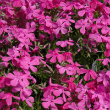
Deep pink blooms. Evergreen groundcover. Native. USDA 3-8
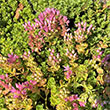
Pink blooms. Green foliage. Evergreen. Moderate foot traffic. USDA 3-8
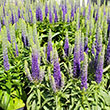
Deep blue-purple blooms. Upright compact foliage. USDA 3-8
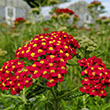
Cherry-red, gold centered flowers, later fading to light pink and creamy yellow. Spreading fern-like foliage. USDA 3-8
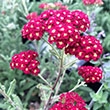
Rich strawberry red flowers with a yellow eye atop feathered foliage with a robust compact habit. USDA 3-8
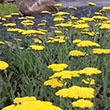
Clumping, compact hybrid with fern-like, aromatic, silvery foliage. Long-lasting, bright lemon-yellow flowers. USDA 3-8
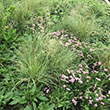
Clustered rose pink flowers that age to a soft creamy pink. Prefers well-drained soils. USDA 3-8
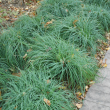
Height: 8 inches
Spread: 12 inches
Sunlight: partial shade, full shade
Hardiness Zone: 3a
Other Names: Oak Sedge
Description:
This shade loving native sedge features soft, arching semi-evergreen foliage; excellent in rock gardens, containers, or as a groundcover; prefers part shade and dry to medium moisture; tough and adaptable
Ornamental Features:
Pennsylvania Sedge is primarily valued in the garden for its cascading habit of growth. Its grassy leaves remain forest green in color throughout the season.
Landscape Attributes:
Pennsylvania Sedge is an herbaceous perennial grass with a shapely form and gracefully arching stems. It brings an extremely fine and delicate texture to the garden composition and should be used to full effect.
This is a relatively low maintenance plant, and is best cleaned up in early spring before it resumes active growth for the season. It has no significant negative characteristics.
Pennsylvania Sedge is recommended for the following landscape applications:
- Mass Planting
- Rock/Alpine Gardens
- Border Edging
- General Garden Use
- Groundcover
- Container Planting
- Planting & Growing
Pennsylvania Sedge will grow to be about 8 inches tall at maturity, with a spread of 12 inches. Its foliage tends to remain low and dense right to the ground. It grows at a slow rate, and under ideal conditions can be expected to live for approximately 10 years. As an herbaceous perennial, this plant will usually die back to the crown each winter, and will regrow from the base each spring. Be careful not to disturb the crown in late winter when it may not be readily seen!
This plant does best in partial shade to shade. It prefers to grow in average to dry locations, and dislikes excessive moisture. It is not particular as to soil type or pH. It is somewhat tolerant of urban pollution. Consider applying a thick mulch around the root zone in both summer and winter to conserve soil moisture and protect it in exposed locations or colder microclimates. This species is native to parts of North America. It can be propagated by division.
Pennsylvania Sedge is a fine choice for the garden, but it is also a good selection for planting in outdoor pots and containers. It is often used as a 'filler' in the 'spiller-thriller-filler' container combination, providing the canvas against which the thriller plants stand out. Note that when growing plants in outdoor containers and baskets, they may require more frequent waterings than they would in the yard or garden.
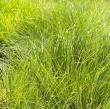
Height: 6 inches
Spread: 18 inches
Sunlight: partial shade full shade
Hardiness Zone: 3a
Description:
A weeping, perennial native sedge that forms graceful, mounded tufts of very fine textured, deep green, threadlike foliage; thrives in dry to mesic woods and does best with some shade; perfect for massing, slopes, or as a shade groundcover
Ornamental Features:
Appalachian Sedge is primarily valued in the garden for its cascading habit of growth. Its attractive threadlike leaves remain forest green in color throughout the season.
Landscape Attributes:
Appalachian Sedge is an herbaceous perennial grass with a shapely form and gracefully arching stems. It brings an extremely fine and delicate texture to the garden composition and should be used to full effect.
This is a relatively low maintenance plant, and is best cleaned up in early spring before it resumes active growth for the season. It has no significant negative characteristics.
Appalachian Sedge is recommended for the following landscape applications:
- Mass Planting
- Rock/Alpine Gardens
- Border Edging
- Groundcover
- Naturalizing And Woodland Gardens
- Container Planting
Planting & Growing:
Appalachian Sedge will grow to be only 6 inches tall at maturity, with a spread of 18 inches. Its foliage tends to remain low and dense right to the ground. It grows at a medium rate, and under ideal conditions can be expected to live for approximately 10 years. As an herbaceous perennial, this plant will usually die back to the crown each winter, and will regrow from the base each spring. Be careful not to disturb the crown in late winter when it may not be readily seen!
This plant does best in partial shade to shade. It prefers to grow in average to dry locations, and dislikes excessive moisture. It is considered to be drought-tolerant, and thus makes an ideal choice for a low-water garden or xeriscape application. This plant should not require much in the way of fertilizing once established, although it may appreciate a shot of general-purpose fertilizer from time to time early in the growing season. It is not particular as to soil type or pH. It is somewhat tolerant of urban pollution. This species is native to parts of North America. It can be propagated by division.
Appalachian Sedge is a fine choice for the garden, but it is also a good selection for planting in outdoor pots and containers. It is often used as a 'filler' in the 'spiller-thriller-filler' container combination, providing a canvas of foliage against which the thriller plants stand out. Note that when growing plants in outdoor containers and baskets, they may require more frequent waterings than they would in the yard or garden.
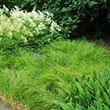
Low, clumping, chartreuse grass-like foliage. Naturalizing. Native. USDA 3-8
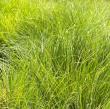
Dense, mounding, native variety. Wonderful when planted in masses. USDA 3-8
52 found, showing page 2 of 4












